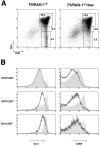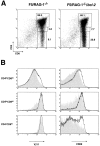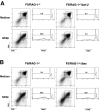The action of Bax and bcl-2 on T cell selection
- PMID: 9743531
- PMCID: PMC2212546
- DOI: 10.1084/jem.188.6.1125
The action of Bax and bcl-2 on T cell selection
Abstract
T cell development and selection in the thymus are shaped by the induction of apoptosis. However, a direct role in T cell development and selection for any of the molecules known to regulate apoptosis has remained controversial. We have studied the effect of bax and bcl-2 transgenes in recombination activation gene 1-deficient (RAG-1(-/-)) mice transgenic for the major histocompatibility complex class I-restricted F5 T cell receptor. Overexpression of a bax transgene in the thymus seriously impairs the production of mature T cells, whereas bcl-2 overexpression greatly promotes it. The effect of bax and bcl-2 overexpression on antigen-induced negative selection was studied using fetal thymic organ cultures. This analysis showed that Bcl-2 strongly inhibits negative selection, whereas Bax does not affect it. Our data directly show that Bcl-2 family members have specific roles in T cell selection and also lend support to the hypothesis that Bax and Bcl-2 can antagonize each other's action in a certain apoptosis pathway while in another they can be functionally nonreciprocal.
Figures






Similar articles
-
Elevated Bcl-2 is not a causal event in the positive selection of T cells.Eur J Immunol. 2001 Jun;31(6):1876-82. doi: 10.1002/1521-4141(200106)31:6<1876::aid-immu1876>3.0.co;2-f. Eur J Immunol. 2001. PMID: 11433384
-
Overexpression of Bcl-2 differentially restores development of thymus-derived CD4-8+ T cells and intestinal intraepithelial T cells in IFN-regulatory factor-1-deficient mice.J Immunol. 2001 Jun 1;166(11):6509-13. doi: 10.4049/jimmunol.166.11.6509. J Immunol. 2001. PMID: 11359801
-
BCL-XL-regulated apoptosis in T cell development.Int Immunol. 1997 Sep;9(9):1375-84. doi: 10.1093/intimm/9.9.1375. Int Immunol. 1997. PMID: 9310841
-
Bax. The pro-apoptotic Bcl-2 family member, Bax.Int J Biochem Cell Biol. 1998 Jun;30(6):647-50. doi: 10.1016/s1357-2725(98)00006-5. Int J Biochem Cell Biol. 1998. PMID: 9695020 Review.
-
Cell death, Bcl-2, Bax, and the cerebellum.Cerebellum. 2002 Dec;1(4):277-87. doi: 10.1080/147342202320883588. Cerebellum. 2002. PMID: 12879966 Review.
Cited by
-
Essential role of PI3Kdelta and PI3Kgamma in thymocyte survival.Blood. 2006 Mar 15;107(6):2415-22. doi: 10.1182/blood-2005-08-3300. Epub 2005 Nov 22. Blood. 2006. PMID: 16304053 Free PMC article.
-
The Adaptation Model of Immunity: Signal IV Matters Most in Determining the Functional Outcomes of Immune Responses.J Immunol. 2023 Mar 1;210(5):521-530. doi: 10.4049/jimmunol.2200672. J Immunol. 2023. PMID: 36881868 Free PMC article.
-
Asymmetric thymocyte death underlies the CD4:CD8 T-cell ratio in the adaptive immune system.Proc Natl Acad Sci U S A. 2013 Jul 30;110(31):E2905-14. doi: 10.1073/pnas.1304859110. Epub 2013 Jul 15. Proc Natl Acad Sci U S A. 2013. PMID: 23858460 Free PMC article.
-
Bcl-2 Is Necessary to Counteract Bim and Promote Survival of TCRαβ+CD8αα+ Intraepithelial Lymphocyte Precursors in the Thymus.J Immunol. 2022 Feb 1;208(3):651-659. doi: 10.4049/jimmunol.2100975. Epub 2022 Jan 7. J Immunol. 2022. PMID: 34996838 Free PMC article.
-
Regulation of positive and negative selection and TCR signaling during thymic T cell development by capicua.Elife. 2021 Dec 13;10:e71769. doi: 10.7554/eLife.71769. Elife. 2021. PMID: 34895467 Free PMC article.
References
-
- Sha WC, Nelson CA, Newberry RD, Kranz DM, Russell JH, Loh DY. Positive and negative selection of an antigen receptor on T cells in transgenic mice. Nature. 1988;36:73–76. - PubMed
-
- Kisielow P, Teh H-S, Bluthmann H, von Boehmer H. Positive selection of antigen-specific T cells in thymus by restricting MHC molecules. Nature. 1988;335:730–733. - PubMed
-
- Teh H-S, Kisielow P, Scott B, Kishi H, Uematsu Y, Bluthmann H, von Boehmer H. Thymic major histocompatibility complex antigens and the αβ T-cell receptor determine the CD4/CD8 phenotype of T cells. Nature. 1988;335:229–233. - PubMed
-
- Scott B, Bluthmann H, Teh HS, von Boehmer H. The generation of mature T cells requires interaction of the αβ T-cell receptor with major histocompatibility antigens. Nature. 1989;338:591–593. - PubMed
-
- Kisielow P, Bluthmann H, Staerz UD, Steinmetz M, von Boehmer H. Tolerance in T-cell receptor transgenic mice involves deletion of nonmature CD4+CD8+thymocytes. Nature. 1988;333:742–746. - PubMed
Publication types
MeSH terms
Substances
LinkOut - more resources
Full Text Sources
Molecular Biology Databases
Research Materials
Miscellaneous

